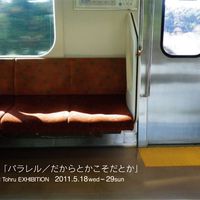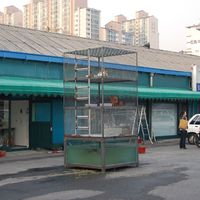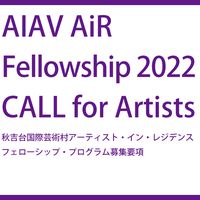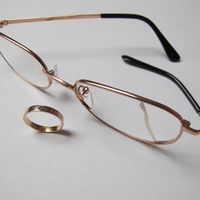Exchanging artistic ideals and values | residency programmes in Japan
 Artists Jasmina Llobet and Luis Fernández Pons spent a month in Japan in September 2011 on a residency at Akiyoshidai International Art Village. They then travelled through the country visiting other artist-in-residency programmes and offer their impressions and advice to artists considering applying for a residency in Japan.
Artists Jasmina Llobet and Luis Fernández Pons spent a month in Japan in September 2011 on a residency at Akiyoshidai International Art Village. They then travelled through the country visiting other artist-in-residency programmes and offer their impressions and advice to artists considering applying for a residency in Japan.In Japan many public and private initiatives offer residency programmes and exchange projects with international institutions. Artists from around the world have been attracted to such programmes in this unique country. Despite this, there is seldom any continuity or follow-up to these stays. Based on personal meetings with the coordinators and directors of several institutions, we aim to give an overview of the current situation of residencies in Japan. We find them thrilling and sometimes precarious ways of exchanging artistic ideals and values on a global level.
In the past two years we have visited several artist-in-residence programmes all over Japan. This has become sort of a ritual in our travels – as artists, we love to visit places where art is not just exhibited, but is also created. In September 2011 we were again in Japan, where visited more residencies and can therefore offer some personal recommendations to artists.
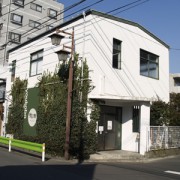 Through this investigation we aimed to understand better the creation process and the conditions under which artists work in Japan, by taking artist-in-residence programmes as an indicator of the state of the arts. In Japan, residency programmes are very diverse, but many have been created and are run by individuals; these are usually non-commercial with rather low budgets. Such initiatives have to stimulate creativity with very little means, and are possible only thanks to those committed people who care about them. Some residency programmes look for private or public sponsorship for certain projects, but the possibilities are quite limited. Of course there are also some totally public-funded residencies (really only a few). But sadly, in general, we should point out that we found an almost non-existent commitment of public institutions to contemporary art in Japan, at all levels.
Through this investigation we aimed to understand better the creation process and the conditions under which artists work in Japan, by taking artist-in-residence programmes as an indicator of the state of the arts. In Japan, residency programmes are very diverse, but many have been created and are run by individuals; these are usually non-commercial with rather low budgets. Such initiatives have to stimulate creativity with very little means, and are possible only thanks to those committed people who care about them. Some residency programmes look for private or public sponsorship for certain projects, but the possibilities are quite limited. Of course there are also some totally public-funded residencies (really only a few). But sadly, in general, we should point out that we found an almost non-existent commitment of public institutions to contemporary art in Japan, at all levels.Working from north to south Japan, here are brief details of the residency programmes we visited:
Toride Art Project (Toride) is a programme run in collaboration with the Art University of Tokyo and has a focus on community projects. Located about one hour from Tokyo, we met Yasue Habara who explained their work. We understood that this project is possible only through the commitment and effort of a few individuals, and through a long tradition of personal dedication.
Tokyo Wonder Site (Tokyo) is amazingly well situated, and they have done very professional work over the past years. Artists can live and work in the very heart of Tokyo, at walking distance from Omotesando and Harajuku. The charismatic Yusaku Imamura runs the programme and has established an interesting network of exchanges with other similar institutions.
Youkobo (Tokyo), in the multicultural area of Ogikubo, is a private initiative of Hiroko and Tatsuhiko Murata, with years of experience of projects on the Tokyo art scene. Youkobo has no support from any institution and is financed by the directors themselves and by the participating artists, who have to seek funding in their home countries for their stays.
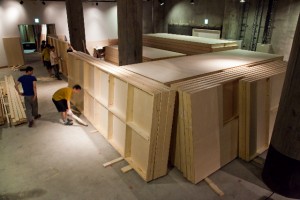 Bankart1929 (Yokohama) has an impressive exhibition space, a huge museum-like building with raw walls. This year, part of Yokohama Triennale was held there. The exhibition programme is the priority for Bankart1929, so the residency adapts to the needs of the exhibition space. Exhibiting artists are invited to stay at the residency in order to create their work on site.
Bankart1929 (Yokohama) has an impressive exhibition space, a huge museum-like building with raw walls. This year, part of Yokohama Triennale was held there. The exhibition programme is the priority for Bankart1929, so the residency adapts to the needs of the exhibition space. Exhibiting artists are invited to stay at the residency in order to create their work on site.Kyoto Art Center (Kyoto) has a multidisciplinary focus: theatre, dance, music & visual arts. Satoko Kiyosawa explained that each year two artists or artist groups working in one arts discipline are selected through an open call. With the rotation of art forms, 2012 is the year for visual artists to apply. Conveniently located in Kyoto's downtown, the building is quite untypical for an art centre – they share a building with a school. In spite of the reduced space, the exhibitions are interesting.
Ohara Museum (Kurashiki) – here we met Sara Durt and we soon realised this is a very popular museum for Japanese tourists who come to see the Western art collection of the Ohara family, including works by major artists like Cezanne or Matisse. Apart from the museum they also run a small residency programme. Usually Japanese artists are invited, but they are open to international artists too.
AIAV - Akiyoshidai International Art Village (Yamaguchi) is a public centre dependent on the local government of Yamaguchi. Located between mountains and surrounded by nature, AIAV is housed in an impressive architectural project by Arata Isozaki. The residency is quite isolated, which allows artists to concentrate on their work and get away from the urban environment and everyday concerns. AIAV develops a very interesting exhibition programme including local as well as international artists. This residency enjoys much recognition abroad and calls for international applications once a year, in August.
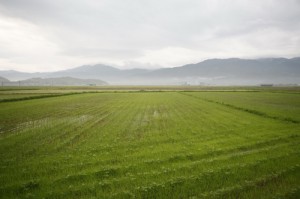 Studio Kura (Itoshima). Director Hirofumi Matsuzaki started this programme in 2007, inviting artists to spend a month in a rural environment in southern Japan. The building used to be a rice warehouse and is now used for presentations of artists and for the residency. Studio Kura's programme is by invitation only, but they are open for artists to send their portfolios. Artists’ stays at Studio Kura's are often based on exchange projects with similar institutions in other countries, otherwise artists have to search for funding for their expenses.
Studio Kura (Itoshima). Director Hirofumi Matsuzaki started this programme in 2007, inviting artists to spend a month in a rural environment in southern Japan. The building used to be a rice warehouse and is now used for presentations of artists and for the residency. Studio Kura's programme is by invitation only, but they are open for artists to send their portfolios. Artists’ stays at Studio Kura's are often based on exchange projects with similar institutions in other countries, otherwise artists have to search for funding for their expenses.More information on artists’ residencies in Japan:
AIR_J – an online database of Artist-in-Residence programmes in Japan
Res Artis – an international network of artist residencies
Trans Artists – a guide to international artist-in-residence programmes
Jasmina Llobet and Luis Fernández Pons are a Spanish visual artist collective (Llobet & Pons) based in Berlin and working together since 2002 across the fields of installation, object sculpture and art in public space. They both hold a Meisterschüler degree in Fine Art from Berlin University of the Arts. Very interested in exchange programmes and artist initiatives, in the last years they have participated in many residencies in European and Asian countries, for example at AIAV Akiyoshidai International Art Village in Japan; Seoul Art Space Geumcheon in South Korea and Platform Garanti in Turkey. And also they have presented their works at international art spaces like Studio1 - Bethanien and The Process Room at the Irish Museum of Modern Art.
A second article in this series by Llobet & Pons looks at independent project spaces and artist-run initiatives in Japan
See also: Culture360 2010 article 'Nomadic Artists'
See also: article on 'Where do we go from here?' exhibition and Asian artists residency programme at Tokyo Wonder Site, October/November 2011.
Images of residencies in Japan (from top): Tokyo Wonder Site (Aoyama), Youkobo, Bankart1929, Studio Kura
Similar content
03 Dec 2010
deadline
01 Aug 2011
deadline
08 May 2015
deadline
20 Jan 2022

